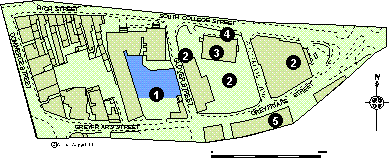 Elgin: Area 5
Elgin: Area 5This page was copied from: http://www.suat.demon.co.uk/elgin_bs/elgin_a5.htm for informational and historical purposes. Please note original copyright at bottom of page. Duffuses had an early presence in Elgin.
 Elgin: Area 5
Elgin: Area 5

Defined by High Street and South College Street to the north, Greyfriars Street to the south and Commerce Street to the west. It contains the two sites of the Franciscan friary.
Click here for a full size map (27K)
A watching brief in 1990 by SUAT located the remains of a stone building, probably a cell of the late 19th to 20th century jail which formerly stood on the site. Natural sand was revealed at 0.65 m below modern ground level across the rest of the site. (Hall 1990, 21).
Trial excavations in 1989 by SUAT located a limited amount of medieval activity represented by a few residual sherds of pottery on the putative site of the 13th century Franciscan Friary (Cachart 1989, 24).
The Franciscan or Grey friars are thought to have occupied two different sites in the burgh. The earliest of the two sites, an incomplete foundation of Friars Minor, was known in the 19th century as being in the garden of Dunfermline cottage, a house that stood at this map location until the 1960s. There are references to foundations and vaults being visible, and to a stone dovecote which stood until the 19th century (Simpson and Stevenson 1982, 32).
Monitoring of contractors' excavations in 1967 by Mr I. Keillar located a vaulted cellar on this site. This may have been part of Dunfermline Cottage (a 19th century building, see 1 above) or possibly part of the Franciscan friary. The same structure was observed again in 1990 by SUAT. (Cachart 1990, 21).
By the late 15th century, the community of Friars, by now known as Observantines, had moved to a new site. This lies on the south side of Greyfriars Street, and was substantially rebuilt in the late 19th century. The conventual buildings, clustered around a court to the south of the church, were rebuilt on the old foundations and incorporate some fragments of the old friary (Simpson and Stevenson 1982, 32).
The trial excavations on the site at South College Street / Greyfriars Street and Glover Street located a small amount of archaeological deposit both above and cut into natural layers. There was no trace of the early Franciscan foundation which is supposed to have stood on the site. The excavator identified greater depths of deposit to the south and north west of the site, probably reflecting the topography. A watching brief in 1990 behind the County buildings located natural sand at 0.64 m below modern ground level.
From this limited archaeological work on the south side of the burgh, it seems that the survival of deposits on the High Street frontage may be better than that on the north side. Whether any archaeological deposits survive on the site of the later Franciscan friary following the 19th century restoration is not known. Any development proposals for this site should be closely monitored. Like Area 4, this part of Elgin is supposed to have developed as part of the 14th century burgh expansion, however from the limited work that has taken place little has been recovered that relates to this.
Copyright © Scottish Urban
Archaeological Trust Limited
55 South Methven Street, PERTH, PH1 5NX
Tel: +44 (0)1738 622393
Fax: +44 (0)1738 631626
E-Mail: derekh@suat.demon.co.uk